- Vriesea: Care
- Light
- Water
- Temperature
- Fertilizer
- Humidity
- Propagation
- Pests
- Pruning
- Additional Care
- Conclusion
- Proper Watering and Lighting
- Watering
- Lighting
- Temperature and Humidity
- Temperature and Humidity Tips
- Vriesea: Photos
- Beautiful Varieties
- Stunning Blooms
- Vriesea: Types
- Tillandsioideae Subfamily
- Popular Cultivars
- Vriesea ‘Flaming Sword’
- Vriesea ‘Painted Feather’
- Vriesea ‘Splendens’
- Vriesea ‘Red Chestnut’
- Vriesea ‘Tiffany’
- Vriesea: Everything You Need to Know
- Introduction
- Care
- Types of Vriesea
- Conclusion
- Q&A:
- What is Vriesea?
- What are the care requirements for Vriesea plants?
- How often should I water my Vriesea plant?
- Can Vriesea plants tolerate low light conditions?
- What types of Vriesea plants are there?
- How do I propagate Vriesea plants?
- Are Vriesea plants toxic to pets?
- Video: Aechmea bromeliads explained- care, maintenance, light, water requirements
Vriesea is a genus of bromeliads native to the tropical regions of Central and South America. These plants are known for their vibrant and exotic-looking foliage, as well as their stunning, long-lasting flower spikes. With over 250 species, Vriesea offers a wide variety of options for indoor and outdoor gardening enthusiasts.
When it comes to caring for Vriesea, these plants thrive in bright indirect light and require well-draining soil. They prefer high humidity levels, so misting or placing the pot on a tray filled with water can help create the perfect environment. Watering should be done sparingly, allowing the soil to dry out slightly between waterings.
One of the most striking features of Vriesea are its flowers. The flower spikes can last for several months, providing a burst of color and beauty to any space. These plants are also known for their architectural foliage, with some species showcasing leaves that curl and twist in unique and intricate patterns.
There are several popular types of Vriesea, each with its own distinct characteristics. Vriesea splendens, also known as flaming sword, is a popular choice for its tall, sword-like flower spikes and bold, red bracts. Vriesea hieroglyphica, on the other hand, is known for its unusual leaf patterns resembling ancient hieroglyphs.
Whether you’re an experienced plant collector or a beginner looking to add some tropical flair to your home, Vriesea is a versatile and beautiful plant that is sure to impress. With a little care and attention, you can enjoy the stunning foliage and vibrant blooms of this unique genus.
Check out our collection of photos below to see some of the stunning varieties of Vriesea and get inspired to add one of these beauties to your own plant collection.
Vriesea: Care
Light
Vriesea plants prefer bright, indirect light. They can tolerate some direct sunlight, but too much can burn their leaves. Place your Vriesea plant near a window with filtered light or in an area with bright, indirect light.
Water
Water your Vriesea plant when the top inch of soil feels dry. Pour water into the center of the rosette, allowing it to soak into the soil. Avoid overwatering, as this can lead to root rot. It’s important to use water that is at room temperature or slightly warm to avoid shocking the plant.
Temperature
Vriesea plants prefer temperatures between 65°F and 75°F (18°C – 24°C). They can tolerate slightly higher temperatures, but it’s best to keep them away from drafts or extreme temperature fluctuations.
Fertilizer
Feed your Vriesea plant monthly during the growing season with a balanced, water-soluble fertilizer. Dilute the fertilizer to half the recommended strength. Avoid fertilizing during the winter months when the plant is dormant.
Humidity
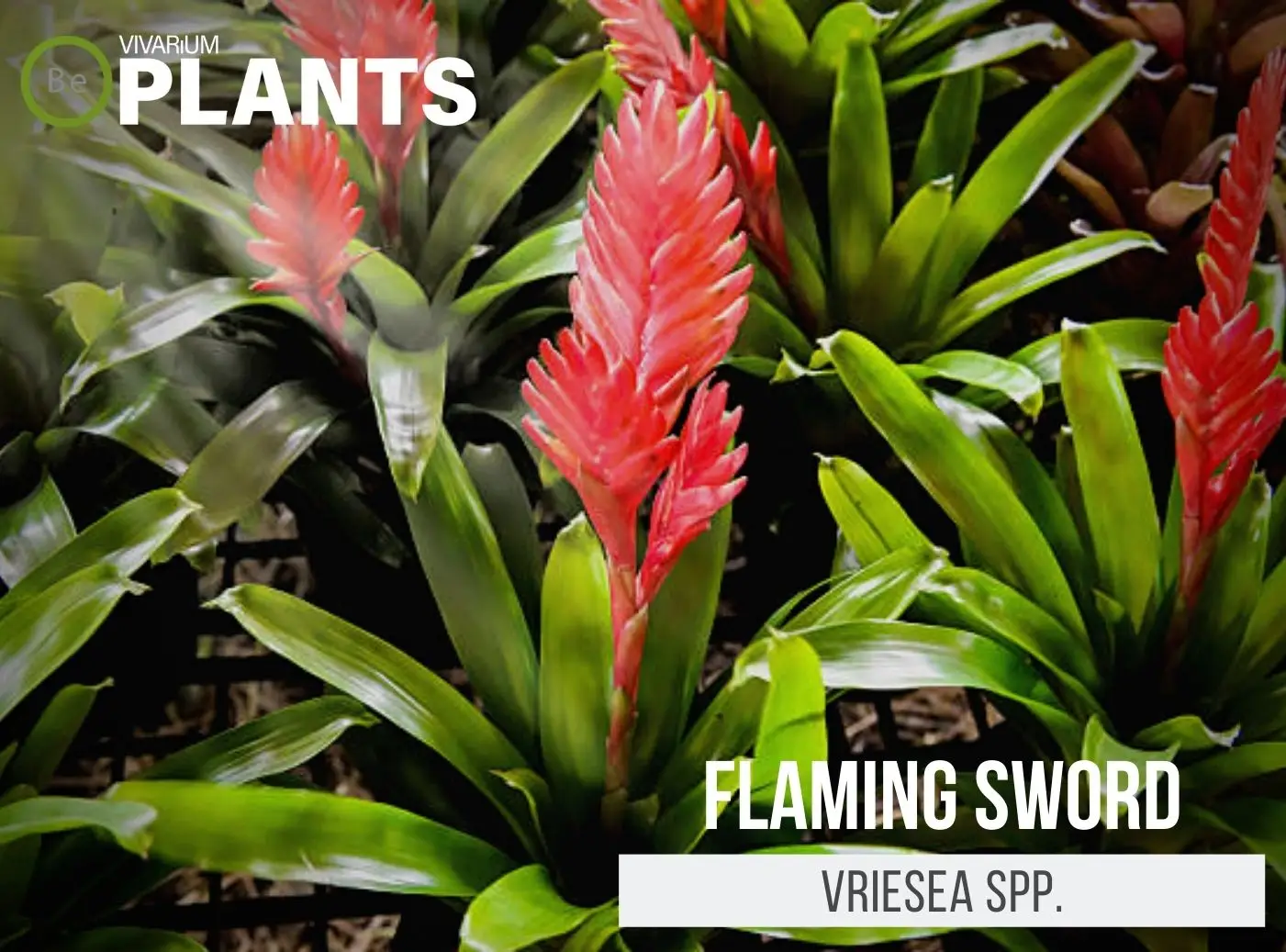
Vriesea plants prefer high humidity levels. You can increase humidity by placing the plant on a tray filled with water and pebbles or by using a humidifier. Misting the leaves regularly can also help increase humidity.
Propagation
Vriesea plants can be propagated through offsets or pups that grow from the base of the mother plant. Carefully remove the pups with a clean knife or shears and plant them in a well-draining potting mix. Keep the soil slightly moist until the pups establish roots.
Pests
Common pests that can affect Vriesea plants include mealybugs, scale insects, and spider mites. Check your plant regularly for signs of infestation, such as sticky residue, webbing, or yellowing leaves. Treat any infestations promptly with insecticidal soap or neem oil.
Pruning
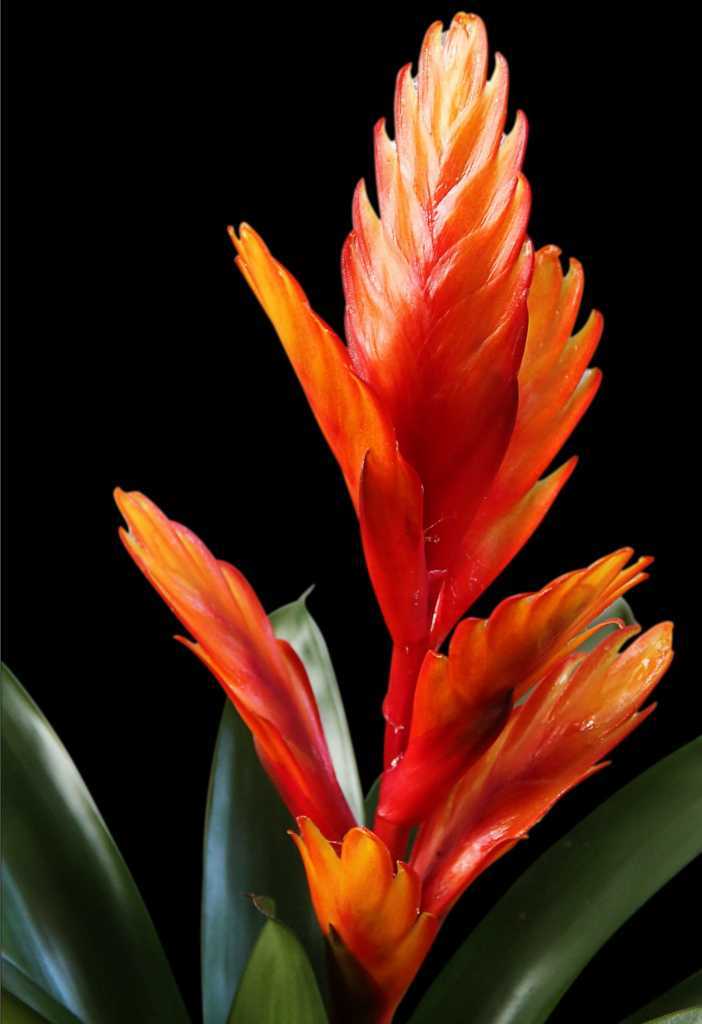
Prune any dead or dying leaves from your Vriesea plant to maintain its appearance and overall health. Use clean garden shears or scissors to remove the leaves at the base of the plant, being careful not to damage the healthy foliage.
Additional Care
- Avoid exposing your Vriesea plant to cold drafts or extreme temperatures.
- Use a well-draining potting mix to prevent waterlogged soil.
- Rotate your plant occasionally to ensure even growth and prevent it from leaning towards the light.
- Avoid misting the flowers, as this can cause them to rot.
Conclusion
By following these care tips, you can keep your Vriesea plant healthy and thriving. Remember to provide it with the right amount of light, water, and temperature, and it will reward you with beautiful foliage and stunning flowers.
Proper Watering and Lighting
Proper watering and lighting are essential for the health and well-being of Vriesea plants. Here are some tips to ensure that your Vriesea receives the care it needs:
Watering
- Water your Vriesea thoroughly once a week, allowing the soil to become moderately dry between waterings. Avoid overwatering, as this can lead to root rot.
- Use room temperature water or rainwater to prevent mineral buildup in the soil. Avoid using hard tap water, as the excess minerals can damage the plant.
- Water the plant at the base, avoiding getting water on the leaves or in the central cup of the plant. Standing water in the central cup can cause rot and attract pests.
- During the growth period in spring and summer, increase watering frequency to twice a week if the weather is particularly hot and dry.
Lighting
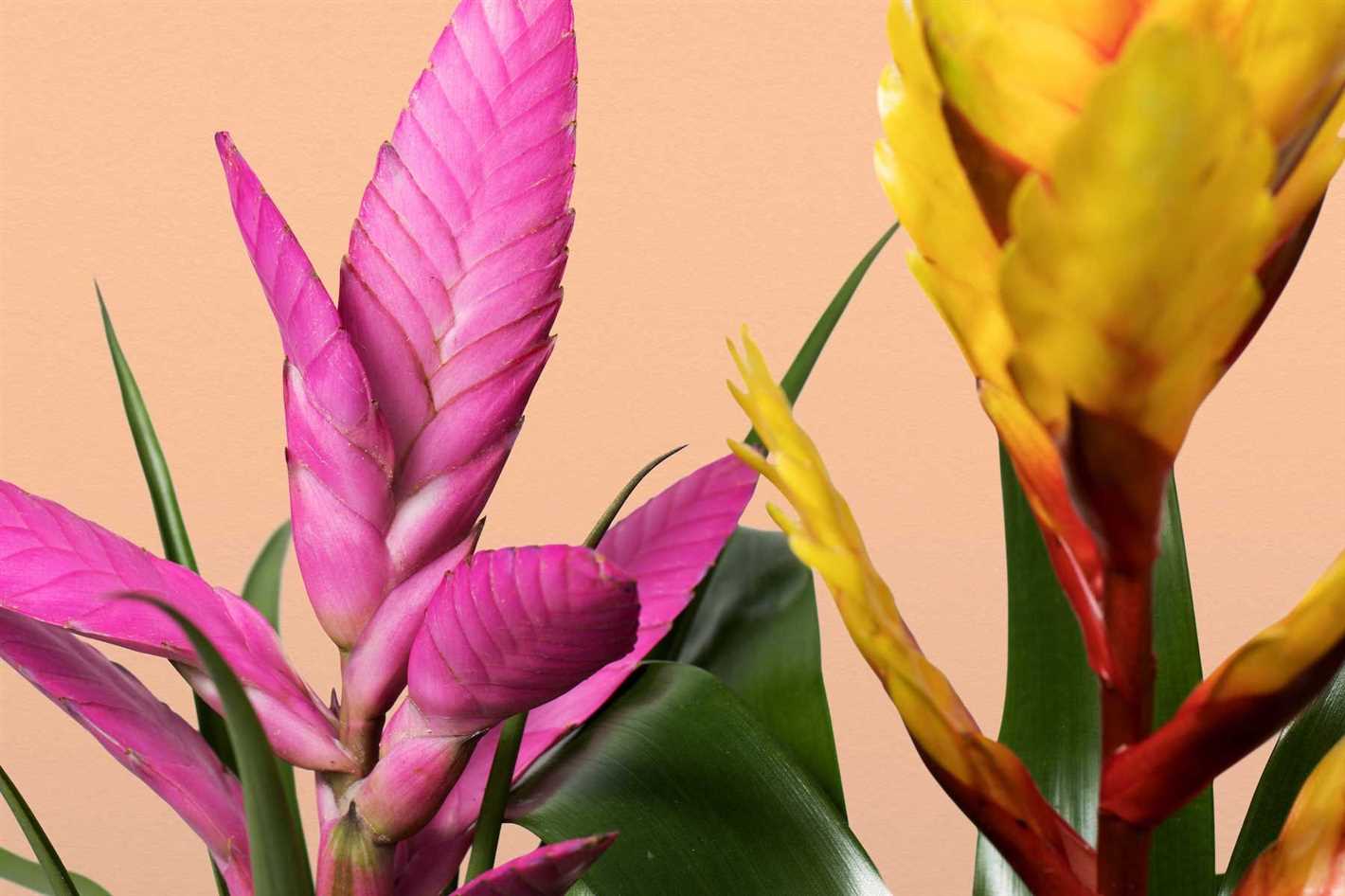
- Place your Vriesea plant in bright, indirect sunlight. Direct sunlight can scorch the leaves, while too little sunlight can result in poor growth and blooming.
- Avoid placing the plant in full shade, as this can cause the leaves to become elongated and floppy.
- If you notice the leaves turning pale green or yellowish, it may be an indication that the plant is receiving too much light. Move the plant to a slightly shadier location.
- If you notice the leaves becoming dark green or red, it may be an indication that the plant is receiving too little light. Move the plant to a brighter location.
By following these watering and lighting guidelines, you can help your Vriesea plant thrive and flourish. Remember to monitor the plant closely and make adjustments to its care as needed.
Temperature and Humidity
Vriesea plants thrive in warm temperatures, ideally ranging from 60 to 85 degrees Fahrenheit (15 to 29 degrees Celsius). They are native to tropical regions and require a relatively high temperature to grow and flower properly. Avoid exposing them to temperatures below 50 degrees Fahrenheit (10 degrees Celsius) as they can suffer damage or die.
These plants also appreciate moderate to high humidity levels, as they naturally grow in humid environments. Aim for a humidity level of 50% to 70% to keep your Vriesea healthy. If the air in your home is dry, you can increase the humidity by using a humidifier or placing the plant on a tray filled with water and pebbles. Misting the leaves with water can also help to maintain proper humidity.
It is important to note that while Vriesea plants enjoy humidity, they also require good airflow to prevent fungal diseases. Avoid placing the plant in a location with stagnant air.
Temperature and Humidity Tips
- Keep the temperature within the ideal range of 60-85 degrees Fahrenheit (15-29 degrees Celsius).
- Avoid exposing the plant to temperatures below 50 degrees Fahrenheit (10 degrees Celsius).
- Maintain a humidity level of 50% to 70%.
- Provide good airflow to prevent fungal diseases.
- Increase humidity with the help of a humidifier, water-filled tray, or misting the leaves.
By providing the optimal temperature and humidity conditions for your Vriesea plant, you can help it thrive and produce beautiful flowers.
Vriesea: Photos
Here are some stunning photos of Vriesea plants to inspire you:
 – This beautiful Vriesea has vibrant red and yellow leaves.
– This beautiful Vriesea has vibrant red and yellow leaves. – A close-up of a Vriesea flower with its distinctive floral bracts.
– A close-up of a Vriesea flower with its distinctive floral bracts. – A Vriesea plant with variegated leaves, adding a touch of uniqueness to any space.
– A Vriesea plant with variegated leaves, adding a touch of uniqueness to any space. – The long, slender leaves of this Vriesea create an elegant and graceful display.
– The long, slender leaves of this Vriesea create an elegant and graceful display.
These photos showcase the diversity and beauty of Vriesea plants. Whether you prefer bold colors or more subtle variegation, there is a Vriesea species to suit every taste and style. Use these photos as inspiration for incorporating Vriesea plants into your own indoor or outdoor gardening projects.
Beautiful Varieties
- Vriesea splendens: This is one of the most popular varieties of Vriesea, known for its vibrant red bracts and tall flower spike. It is a stunning plant that adds a pop of color to any space.
- Vriesea hieroglyphica: With its unique foliage pattern resembling hieroglyphic writing, this variety is a favorite among plant collectors. The leaves have dark green marks on a light green background, making it an eye-catching addition to any plant collection.
- Vriesea carinata: This variety is characterized by its broad, thick leaves that have serrated edges. The leaves are green with contrasting white bands and red undersides, making it a visually striking plant.
- Vriesea fosteriana: This variety is known for its large, broad leaves that are green with red bands. It blooms with bright yellow flowers that contrast beautifully with the foliage, creating a stunning display.
If you have a preference for a specific leaf pattern or color, there is likely a Vriesea variety that suits your taste. These beautiful varieties can be used as focal points or accents in any indoor or outdoor space. Their unique shapes and colors make them stand out in plant collections and add a touch of exotic beauty.
Stunning Blooms
Vriesea plants are known for their stunning blooms, which add a touch of exotic beauty to any space. These plants produce long-lasting flowers that come in a variety of vibrant colors, making them a popular choice among plant enthusiasts.
One of the most remarkable features of Vriesea blooms is their unique shape. The flowers are typically arranged in a spike-like cluster, with each individual flower radiating outwards. This creates a visually striking display that is sure to catch the eye.
Another fascinating aspect of Vriesea blooms is their longevity. Unlike many other flowering plants, Vriesea flowers can last for several weeks to even several months. This extended blooming period ensures that you can enjoy their beauty for an extended period of time.
Some Vriesea varieties produce flowers in bold and vibrant colors such as red, orange, yellow, and pink. These colors create a stunning contrast against the plant’s green foliage and can serve as a focal point in any room.
In addition to their beauty, Vriesea blooms also attract pollinators such as bees and butterflies. This makes them a valuable addition to any garden or outdoor space, as they can contribute to the overall ecosystem by supporting the pollination process.
If you’re looking to add a pop of color and tropical flair to your home or garden, Vriesea plants are an excellent choice. Their stunning blooms, long-lasting flowers, and attractive foliage make them a standout option for plant enthusiasts of all levels of experience.
Vriesea: Types
Vriesea is a genus of flowering plants in the bromeliad family. There are over 250 species of Vriesea, and they come in a wide variety of shapes, colors, and sizes. Here are some common types of Vriesea:
Vriesea splendens: Also known as the flaming sword plant, this is one of the most popular species of Vriesea. It has vibrant red bracts and can grow up to 3 feet tall.
Vriesea hieroglyphica: This species is known for its unique markings on its leaves, which resemble hieroglyphic symbols. The leaves are light green with dark green markings.
Vriesea carinata: This species has long, narrow leaves that curve outward. The leaves are green with red or purple markings.
In addition to these popular types, there are many other species of Vriesea that offer a wide range of colors and textures. Some species have brightly colored bracts, while others have unique leaf shapes or patterns. When selecting a Vriesea, consider the specific conditions in your home or garden to ensure it will thrive in its environment.
Overall, Vriesea plants are a stunning addition to any indoor or outdoor space. Their unique characteristics and beautiful colors make them a popular choice among plant enthusiasts.
Tillandsioideae Subfamily
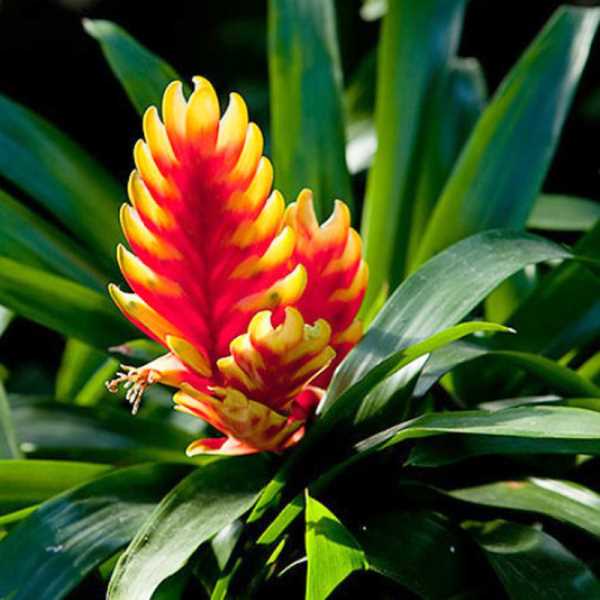
Tillandsioideae is a subfamily of the Bromeliaceae family. It is known for its unique and diverse plants that primarily grow in the Americas. This subfamily includes various genera, such as Tillandsia, Vriesea, Guzmania, and many others.
Characteristics:
- Tillandsioideae plants are typically epiphytic, meaning they grow on other plants or objects for support. They are often seen attaching themselves to trees or rocks, using their roots to anchor themselves in place.
- These plants have specialized leaves that are adapted to absorb moisture from the air. They do not require soil and can survive in a range of environments, including deserts and rainforests.
- The leaves of Tillandsioideae plants are typically long, thin, and often have specialized structures called trichomes. Trichomes help the plants absorb water and nutrients from the air.
Cultivation:
Tillandsioideae plants are popular among enthusiasts due to their unique growth habits and low maintenance requirements. Here are some key tips for their cultivation:
- Light: Most Tillandsioideae plants prefer bright, indirect light. Avoid exposing them to direct sunlight, as it can cause leaf burn.
- Watering: These plants need regular misting or a soak in water. It is essential to provide enough moisture to keep their leaves hydrated. However, overwatering can lead to root rot, so ensure proper drainage.
- Temperature: Tillandsioideae plants thrive in environments with moderate temperatures. They can tolerate higher temperatures during the day but prefer cooler temperatures at night.
- Air Circulation: Good air circulation is crucial for these plants, as it helps prevent moisture buildup and reduces the risk of diseases.
- Fertilizer: Use a diluted bromeliad fertilizer or an orchid fertilizer to provide essential nutrients to the plants. Apply the fertilizer according to the manufacturer’s instructions.
Popular Genera:
| Genus | Common Name |
|---|---|
| Tillandsia | Air Plants |
| Vriesea | Flaming Sword |
| Guzmania | Scarlet Star |
| Neoregelia | Blushing Bromeliad |
Tillandsioideae plants, including Vriesea, offer a stunning array of colors, shapes, and textures. Whether you are a beginner or an experienced gardener, these unique plants can add a touch of beauty and elegance to any space.
Popular Cultivars
There are numerous popular cultivars of Vriesea that are cherished by plant enthusiasts around the world. Here are some of the most sought-after cultivars:
Vriesea ‘Flaming Sword’
This cultivar is known for its unique sword-shaped leaves that have vibrant red and green colors. It can reach a height of up to 2 feet, making it an eye-catching addition to any indoor garden.
Vriesea ‘Painted Feather’
This cultivar features striking foliage with white feather-like markings on its green leaves. It can grow up to 2 feet tall and produces colorful flowers that add a beautiful touch to its overall appearance.
Vriesea ‘Splendens’
Known for its elegant and architectural appearance, ‘Splendens’ has long, narrow leaves with striking green and red colors. It can grow up to 3 feet tall and produces bright orange flowers that last for several weeks.
Vriesea ‘Red Chestnut’
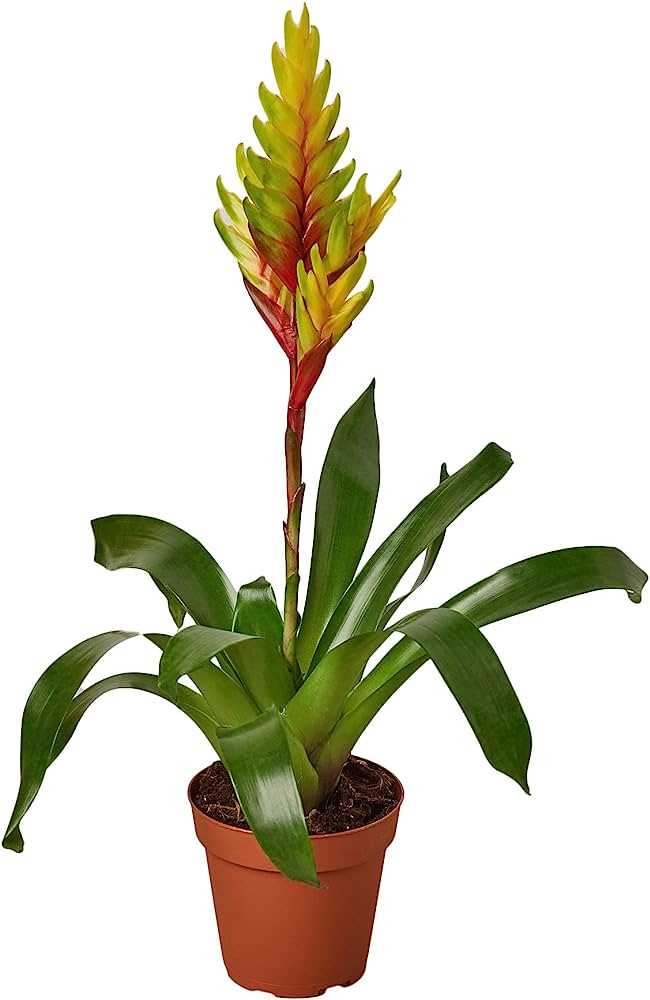
This cultivar stands out with its broad, paddle-shaped leaves that have a chestnut brown color. It can grow up to 2 feet tall and produces bright yellow flowers, adding a striking contrast to its foliage.
Vriesea ‘Tiffany’
‘Tiffany’ is a popular cultivar with a unique leaf shape resembling a star. Its foliage has a mix of green, red, and purple hues. It grows up to 1.5 feet tall and produces vibrant orange flowers that bring a pop of color to any space.
These are just a few examples of the many beautiful cultivars of Vriesea available to plant enthusiasts. Each cultivar has its own unique features and can add a touch of exotic beauty to any indoor garden.
Vriesea: Everything You Need to Know
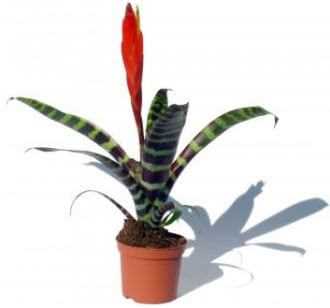
Introduction
Vriesea is a genus of flowering plants in the Bromeliaceae family. These tropical plants are native to the rainforests of Central and South America. They are known for their stunning foliage and vibrant flower spikes.
Care
Vriesea plants are relatively easy to care for, making them suitable for both beginner and experienced gardeners. Here are some key points to keep in mind:
- Light: Vrieseas prefer bright, indirect sunlight. Avoid exposing them to direct sunlight, as it can scorch their leaves.
- Temperature: These plants thrive in temperatures between 60°F and 80°F (15°C – 27°C). They can tolerate slightly lower temperatures for short periods.
- Watering: Water the plant through the central cup or by pouring water directly onto the soil. Keep the cup filled with water to provide humidity. Ensure the soil is well-drained to prevent waterlogged roots.
- Fertilizer: Feed vrieseas with a diluted bromeliad fertilizer once a month during the growing season. Avoid using regular houseplant fertilizers that contain high levels of nitrogen.
- Propagation: Vriesea plants can be propagated through offsets or pups that form at the base of the mature plant. Carefully remove the pup and pot it in a separate container with well-draining potting mix.
- Pruning: Remove any dead or yellowing leaves to maintain the plant’s aesthetics and prevent potential pests or diseases.
Types of Vriesea
There are numerous species and hybrids of vriesea plants, each with its own unique characteristics. Some popular types include:
- Vriesea carinata: This species has dark green leaves with prominent burgundy markings.
- Vriesea splendens: Also known as flaming sword, this plant features long, arching leaves and a vibrant red flower spike.
- Vriesea hieroglyphica: With its striking silver banding and intricate patterns, this vriesea is a true showstopper.
- Vriesea fosteriana: Known for its massive flower spike and wide, glossy green leaves, this variety adds a tropical touch to any space.
Conclusion
Whether you’re a beginner or an experienced gardener, vriesea plants are a wonderful addition to any indoor plant collection. With their stunning foliage and vibrant flower spikes, they are sure to add an exotic touch to your home. By following the proper care guidelines, you can enjoy these tropical beauties for years to come.
Q&A:
What is Vriesea?
Vriesea is a genus of tropical flowering plants in the Bromeliaceae family. They are native to the forests of Central and South America.
What are the care requirements for Vriesea plants?
Vriesea plants require bright indirect light, well-draining soil, and regular watering. They also benefit from high humidity. It is important to avoid overwatering and to provide proper air circulation.
How often should I water my Vriesea plant?
Vriesea plants should be watered when the top inch of soil feels dry. It is important to water thoroughly, allowing the water to drain out of the bottom of the pot. Overwatering can lead to root rot.
Can Vriesea plants tolerate low light conditions?
Vriesea plants prefer bright indirect light, but they can tolerate low light conditions for short periods of time. However, prolonged exposure to low light can cause the plant to become weak and leggy.
What types of Vriesea plants are there?
There are various types of Vriesea plants, including Vriesea splendens, Vriesea hieroglyphica, Vriesea carinata, and Vriesea fenestralis. These plants differ in their leaf shape, color, and flower structure.
How do I propagate Vriesea plants?
Vriesea plants can be propagated through offsets or pups. These are small plants that grow from the base of the parent plant. To propagate, gently remove the offsets from the parent plant and plant them in a separate container with well-draining soil.
Are Vriesea plants toxic to pets?
Vriesea plants are considered non-toxic to cats and dogs. However, it is always a good idea to monitor your pets and prevent them from ingesting any plants.
Video:
Aechmea bromeliads explained- care, maintenance, light, water requirements
 – This beautiful Vriesea has vibrant red and yellow leaves.
– This beautiful Vriesea has vibrant red and yellow leaves. – A close-up of a Vriesea flower with its distinctive floral bracts.
– A close-up of a Vriesea flower with its distinctive floral bracts. – A Vriesea plant with variegated leaves, adding a touch of uniqueness to any space.
– A Vriesea plant with variegated leaves, adding a touch of uniqueness to any space. – The long, slender leaves of this Vriesea create an elegant and graceful display.
– The long, slender leaves of this Vriesea create an elegant and graceful display.






